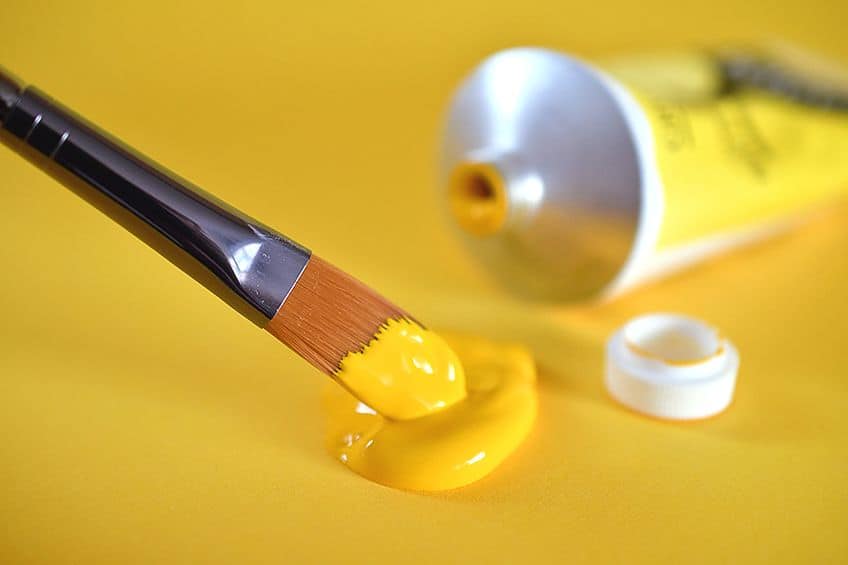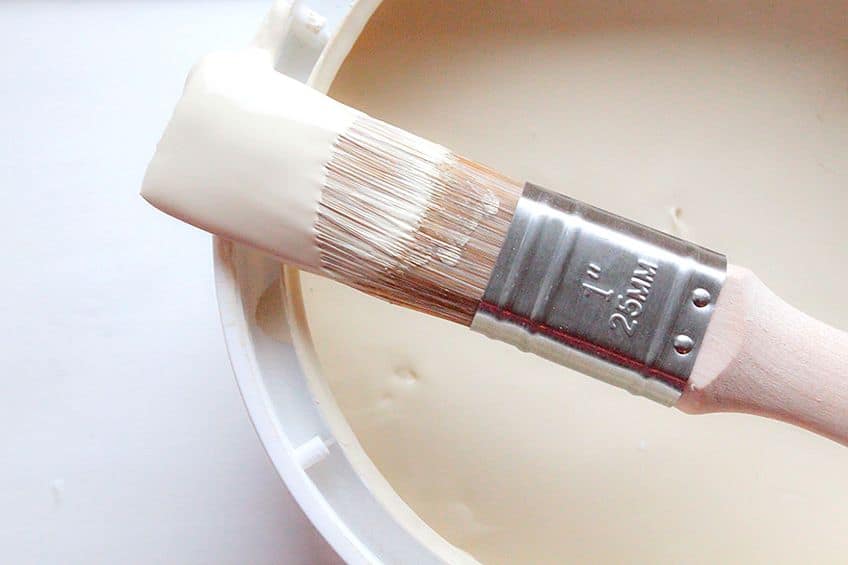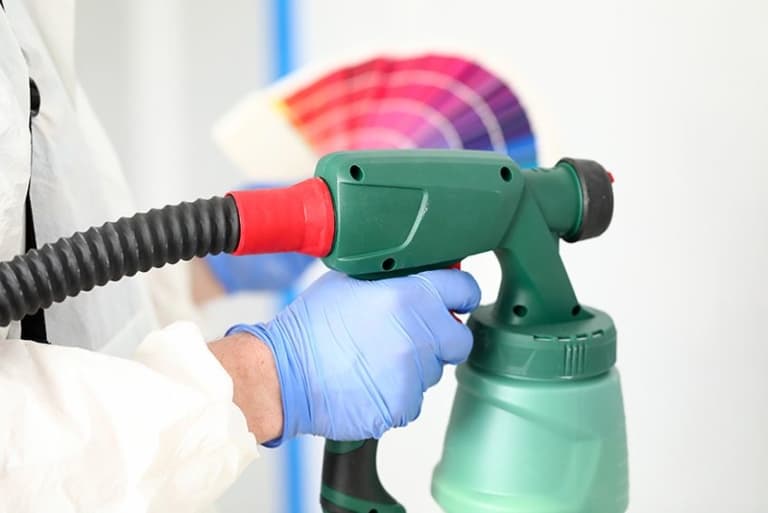Enamel vs Acrylic – Is It Better to Use Enamel or Acrylic Modelling Paint?
Disclosure: There are some affiliate links below and I may receive commissions for purchases made through links in this post, at now additional cost for you.
There are so many different brands and types of paints available to purchase on the market such as paint for your furniture, specialized paint for your home’s outdoor and indoor areas, or paint for an assortment of other arts and crafts projects. It is because of this that you need to understand the differences between enamel and acrylic paint. Both types of paints have their positive and negative attributes, so you will need to select the correct one for your project to achieve the desired results.
What Is Acrylic Paint?
Acrylic paint is a combination of an acrylic polymer blend and color pigments, which together form a non-toxic, water-based paint. This is a popular paint for the arts and crafts industry. Acrylic paint is easy to clean, as you can simply use soap and water to clean it. Several different mediums can be added to acrylic paint to change it in various ways, such as to make it dry quicker or to thicken the paint consistency.
Acrylic paints are normally cheaper than enamel paints and are known to dry very quickly. You can use acrylic paint on many different surfaces including canvas, wood, glass, plastic, fabric, metal, stone, and of course, paper. While you can apply acrylic paint directly to some surfaces, other surfaces (such as metal) will require a little prep work to before you can begin painting.
Working with acrylic paint is simple, as it goes onto the surface evenly and will level out on its own. Occasionally, you will require a primer to ensure that the paint adheres to the surface properly. When working with acrylic paint, you should apply thin layers so that you will not need to wait too long a time in-between coats. This way, you will be able to work quickly and can finish a paint job in no time. When you have finished painting, allow your piece to dry completely.
We recommend using acrylic paint when working with decorative objects or smaller items of furniture.
PROS
- Can change the consistency, texture, and more simply by adding mediums and additives
- Only require soap and water to clean it up
- Available in an assortment of vibrant colors
- Non-toxic and does not give off an odor
- Less expensive than enamel paint
- Dries quickly, allowing for the application of several layers within a shorter space of time
- Certain acrylic paints can provide you with a similar look and finish to that of oil paints
CONS
- Can peel off sometimes
- You will have to work faster due to its fast drying time
- Once completely dried, it can be hard to remove
- To achieve good color depth, you will require many layers of paint
- Does not adhere very well to smooth surfaces
- Provides less coverage
- Brush strokes are sometimes visible
Types of Acrylic Paint
The type of acrylic paint you purchase will depend on what you are doing and what material you will be applying the paint to. Your most expensive option is naturally the best, which would be a professional-grade acrylic paint that offers you long-lasting color and vibrant shades thanks to the high levels of color pigment. There are also student-grade acrylic paints, which tend to be more affordable by offering you lower color pigment levels.

Other Types of Acrylic Paint
- Exterior acrylic paints: These have been designed to stand up to harsher conditions.
- Heavy-body acrylic paints: These are the thickest acrylic paints available.
- Craft acrylic paints: These can be utilized on an assortment of materials and surfaces.
- Soft-body paints: These are easy to mix with an assortment of paint mediums and are quite smooth.
- Acrylic paint spray: An acrylic paint in a spray applicator.
- Fluid acrylic paints: These come in a bottle and can be used to achieve effects such as staining.
- Acrylic marker pens: Acrylic paint-filled pens that can be used for both painting and drawing.
- Acrylic ink: A fluid form of acrylic paint, available in vibrant colors.
- Acrylic gouache: This type offers acrylic paint in a matte, flat, or opaque finish.
- Interactive acrylics: A type of acrylic paint that dries quickly but, thanks to a special unlocking formula, you can reactivate the paint.
- Open acrylic paints: These mimic the effects of oil-based paint, and dry a lot slower than other acrylic paints.
You will be able to paint and create almost anything using these different acrylic paints. If you choose to add varnish to your finished piece, you can protect the paint even further. Keep in mind that you will have to wait at least a week before adding the varnish, as though acrylic paint may dry quickly to the touch, it will take about a week to cure completely.
Acrylic modeling paint is another popular paint product that is simple to use and allows for easy touch-ups. You will be able to find it at your local craft store and it is an easy product to clean up, although it is unfortunately not as durable as enamel model paint.
Best Acrylic Model Paint: VALLEJO Basic Color Paint Set
This set offers you a variety of different colors to choose from, each of which is highly pigmented and lightfast. It is a water-based paint that will adhere well to just about any surface, which is ideal for model painting. If you wish to use the paint in an airbrush, you will just need to add an acrylic thinning medium. When applied, the paint is smooth and no brush strokes are left behind.
- Colors have been formulated with lightfast, permanent pigments
- Opaque color has perfect consistency for smooth application
- Water-based formula can adhere to difficult surfaces
PROS
- Can be used on almost any surface – very versatile
- Goes on evenly
- Offers you a selection of vibrant colors
- Lightfast
CONS
- Can be removed by simply scraping it off
- Expensive
What Is Enamel Paint?
Enamel paint dries to a hard coating and is a solvent-based paint. While acrylic paint has a water base, enamel paint is oil-based. You can use enamel paint on several surfaces including glass, wood, metal, plastic, and its durability makes it great to use on your outdoor surfaces. Once cured, enamel paint is resistant to moisture and you will be able to wash the painted surface often.

Enamel model paint is ideal thanks to the durability and vibrant colors it offers. You do not need to use a primer before applying enamel model paint and, should you need to, you can remove it simply by using some mineral spirits. You can apply enamel paint using either a brush or a roller, or it can be sprayed any of these options will provide you with a long-lasting, glossy finish.
Enamel paints can be used for an assortment of projects including certain appliances, outdoor furniture, handrails, doors, floors, window trims, decks, and even kitchen or bathroom cabinets.
Unfortunately, due to enamel paints being solvent-based, they do give off a strong odor, and their oil base means that they take longer to dry. You can purchase enamel paints in an assortment of finishes, such as matte, gloss, and semi-gloss.
PROS
- Primer usually is not needed
- Provides consistent cover and is simple to apply
- Can be purchased in several different sheens
- Only requires a few coats
- Can be applied to a variety of surfaces and materials
- Does not leave brush strokes
- Provides a durable finish
CONS
- Specialized brushes or rollers are required to apply the paint
- Toxic and gives off an odor
- Expensive
- If stored for too long, the paint can begin to separate
- Limited colors available
- You will require a specialized paint remover or paint stripper
- Can be hard to airbrush – paint will need to be thinned out more so than acrylic paint
- Color can turn yellow or fade over time
- Takes longer to dry
Best Outdoor Enamel Spray Paint: RUST-OLEUM Stops Rust Spray Paint
This product provides your surfaces with a durable and tough coating that has amazing rust resistance. What is great is that it can be used on both exterior and interior surfaces, leaving behind a semi-gloss protective layer. This oil-based paint will take roughly two to four hours to dry to the touch, and the can will cover roughly 15 square feet. The paint is resistant to chipping and fading, and gives your surfaces a glossy finish. It can be used on metal, wood, masonry, and many other surfaces and is available to purchase in several gloss colors.
- Oil-based formula provides a durable protective coating
- Excellent resistance to abrasion, fading and chipping
- Semi-gloss finish provides a subtle shine on surfaces
PROS
- The spray tip is comfortable and the spray applicator allows you to cover hard-to-reach places
- Rust-resistant and durable
- Available to purchase in an assortment of glossy colors
- UV-resistant
- Resistant to chipping and fading
- Can be used on both exterior and interior surfaces
- Provides amazing coverage
CONS
- The spray nozzle can sometimes cause problems
- May give off fumes and a bad odor
What Is the Difference Between Acrylic and Enamel Paint?
To make the best decision when choosing which paint to buy, you need to understand the differences between acrylic and enamel paint. You will save yourself money by selecting the right product for your project the first time. We have put a table together which compares the two types of paints to help you better understand their differences.
| ACRYLIC PAINT | ENAMEL PAINT |
| Available in an assortment of colors | Only available in a few colors |
| A water-based paint that is not as hard as enamel | Oil-based paint, which once dried is very hard |
| Will retain its color | May turn yellow with time |
| A matte finish once dried | A glossy finish once dried |
| Does not give off an odor | Contains volatile organic compounds (VOCs) and will give off a strong odor |
| Water-resistant | Waterproof |
| Dries quickly | It will take a long time to dry |
| A primer is needed most of the time | Does not require a primer |
| Best for use on indoor furniture | Best for use on outdoor furniture |
| You can clean it simply using soap and water | You will require mineral spirits to clean it |
| Ideal for small indoor projects | Amazing to use on bathroom and kitchen cabinets, where the surface is frequently exposed to moisture |
When looking at enamel and acrylic paint, we recommend combining the two in order to get the best of both worlds. To do this, apply a layer of enamel paint over your acrylic paint – the solvents in the enamel paint will slowly raise the coat of the acrylic paint underneath. You can potentially apply a layer of acrylic paint over enamel paint, but you would need to sand the surface of the enamel paint first to prepare the surface. To ensure that you do not face any issues later on, we would recommend that you start painting from scratch.
With regards to spray paint, you may wonder whether acrylic or enamel paint is better. Either type of paint can be used with a spraying unit, but you will probably have to thin out either of the paints before you can begin the application. Alternatively, there are paints on the market that have been pre-thinned, which would then be ideal for spraying.

Frequently Asked Questions
Can You Apply Acrylic Paint on Top of Enamel Paint?
We would suggest that you do not apply acrylic paint on top of enamel paint, as the two paints do not work well together. If you choose to paint enamel paint over acrylic paint, the acrylic paint will begin to peel away and start to chip. If your initial paint is enamel paint, you can sand down the surface, which will allow the acrylic paint to adhere better. However, it is always better to start fresh by removing any existing paint and starting with a clean surface.
Which Is the Better Paint: Enamel or Acrylic?
Each type of paint has its own positive ad negative attributes. Enamel paints are solvent-based and require mineral spirits to be cleaned and thinned, and the paint gives off an odor and toxic fumes. Acrylic paints, on the other hand, only need soap and water to be cleaned and are water-based. Should you wish to thin them out, you can simply can add water. The one you use ultimately boils down to your project’s requirements and, of course, your personal preferences.
How Can You Tell the Difference Between Acrylic and Enamel Paint?
When applied, enamel paint is glossy while acrylic paint has a matte finish. Over time, acrylic paint’s color is preserved, while enamel paint may turn yellow and will begin to fade. Acrylic paint is primarily made up of water, while enamel paint contains solvents.
If I Am Working with Enamel Paints, Will I Require a Primer?
The majority of enamel paints do not require the use of a primer, although using a primer will ensure that your paint lasts longer.
Which Paint is Better for Use on Metals: Enamel or Acrylic?
Enamel paint gives you much better results on metal than acrylic paint, as acrylic paint does not adhere well to smooth surfaces. Enamel paint will also dry hard, forming a durable coat that is rust-resistant.









